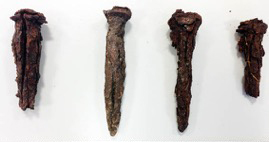Stop 4.2 - Batavia Archaeology: Fastenings
When Commander Francisco Pelsaert returned to rescue the survivors of the Batavia shipwreck, he discovered that a dreadful mutiny had taken place. But with the help of several soldiers, who had managed to evade the mutineers, Pelsaert was able to put down the rebellion. After questioning under torture, six of the principal culprits were executed on Long Island on the 2nd of October 1629.
Hundreds of iron nails and other fastenings were found during an archaeological investigation of Long Island in 2015. The nails on display here are believed to have been used to construct the gallows on which the mutineers were hanged.
In his diary, Commander Pelsaert wrote that the council had long deliberated over the fate of the principal mutineers. Should they be judged once the crew returned to the port of Batavia, or executed immediately, as an example to the others? The men decided on execution. ‘Because some,' the commander wrote, ‘are already impregnated with the bad life, whilst others have sipped a little of the poison, and they could easily become corrupted by the richness of the salvaged wealth [...] Therefore it would not be without danger for the ship and the goods with so many corrupted and half corrupted people to set off to sea [...]' Before being hanged, the mutineers right hands were cut off. As the ringleader, Jeronimus Cornelisz was condemned to have both hands severed. This painful punishment was intended to instil fear in the remaining mutineers and survivors, in order to prevent any further disorder.
In Europe, punishment sites were often considered to be unclean, polluting all that touched them. For this reason, gallows were often erected outside of city walls. Since the materials used to build them were viewed as similarly infected, it was often difficult to find artisans prepared to work with them. The Long Island gallows – and the nails used to construct them – may have been viewed with similar trepidation. The location of the execution site, which was separated from the main site of habitation, might also imply the survivors' unwillingness to remain close to the chosen place of execution.


